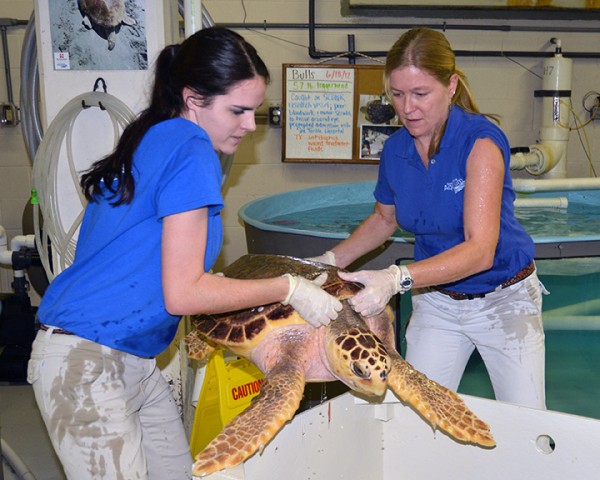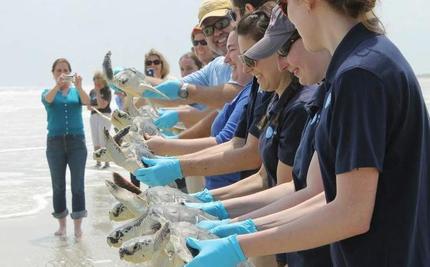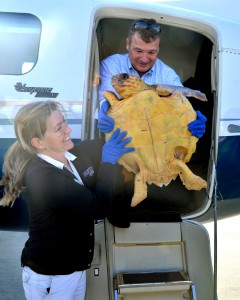52 Sea Turtles Converge on Florida Sand and Swim Free
1 Vote

A ready-for-release turtle named Bulls Bay is moved into a transport container.
- by Laura Simpson
- May 20, 2013

In an experience that any sea turtle conservationist would classify
as simply profound, 52 turtles rescued up and down the Atlantic coast
were lined up along the sand in Jacksonville, Florida for a spectacular
release that left volunteers and bystanders with tear-stained cheeks as
they celebrated the turtles’ return to the blue beyond.
All 52 turtles were released as part of the Sea Turtle Trek that
started in Cape Cod, Massachusetts. Five of those turtles came from the South Carolina Aquarium’s Sea Turtle Rescue Program in
Charleston. In partnership with the South Carolina Department of
Natural Resources, the South Carolina Aquarium’s Sea Turtle Rescue
Program works to rescue, rehabilitate and release sea turtles who get
stranded along the coast. The aquarium’s turtle hospital admits 20 – 30
patients annually and has returned 107 turtles to the sea in recent
years. The average stay for a turtle is about 9 months and runs the
hospital about $36 per day per turtle.
Read more: http://www.care2.com/causes/52-sea-turtles-converge-on-florida-sand-and-swim-free.html#ixzz2TvxEGtOv
The turtles who took part in this release were recovering from a wide
range of injuries and illness. Three of the turtles named McNally,
Kennedy and Kitt were found cold, stunned along the East Coast this
winter. These Kemp’s sea turtles (the most endangered species) were
given several months of fluids, antibiotics and vitamins to correct
blood deficiencies before getting a clean bill of health.
Then there is Ollie, a juvenile green sea turtle who was hit by a
boat on the Folly Fiver. In a lucky twist, Ollie was rescued by an
employee of the National Ocean and Atmospheric Administration (NOAA) who
witnessed the accident. They were able to get him to the aquarium
within two hours and work began to heal the propeller strikes to his jaw
and carapace (shell). In this case, laser therapy was applied to help
accelerate cell growth in the wound.

A turtle named Ollie enjoys his organic lettuce which he ‘forages’ for himself in his tank during recovery.
Any time that a turtle is cleared for release, the animal must be put
back in the ocean within a two week window. During colder months, that
means turtles will either fly south to warmer water temperatures or
hitch a ride by boat out to the jet stream where the water temperatures
are above 70 degrees. In the short video clip below, you can watch the
release of a turtle named Buxton who was brought off shore for his
release.

Boston area private pilot Michael Taylor
recently flew 5 sea turtles to South Carolina to finish their
rehabilitation and to prepare for release.
As coordinated attempts to protect sea turtles continue to expand in
the United States, there are still gaping holes in their conservation
internationally as the hunting of turtles (including endangered species)
continues to be legal in some countries. The sheer suffering that each
turtle endures in this offshoot to the ‘fishing’ industry is of
tremendous concern to animal welfare advocates who understand that the
same physiology which helps turtles to survive for 100 years or more in
the ocean, also forces their bodies to stay alive for extensive periods
of time after they have been captured. Legislative reform, safeguards in
the shrimping industry, nest site protection and enforcement of boating
safety regulations continue to be an imperative for the protection of
sea turtle species worldwide.
If you have an uplifting animal rescue story to share, please visit The Great Animal Rescue website to post your experience and photos. Each month, several of those entries appear right here on Care2.com.
Read more: http://www.care2.com/causes/52-sea-turtles-converge-on-florida-sand-and-swim-free.html#ixzz2Tvx03HSO
Thanks to: http://ascendingstarseed.wordpress.com






 Sat Mar 23, 2024 11:33 pm by globalturbo
Sat Mar 23, 2024 11:33 pm by globalturbo

